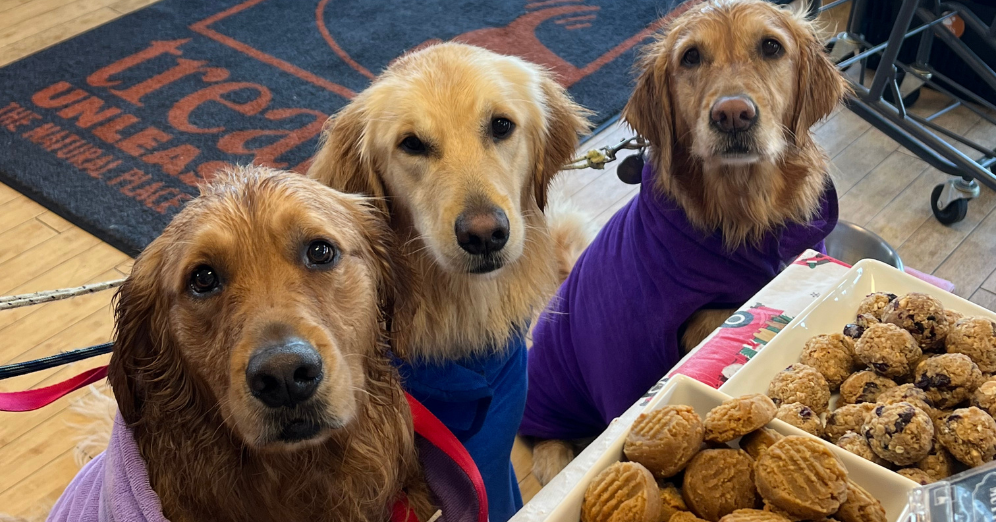A series of educational pet nutrition blogs written by pet experts, just for pet parents.
Cold Weather Essentials
Posted on 01.15.2025
All Treats Unleashed locations are located across Missouri and Kansas, and if you also live in those states, you know that we just came off one of the most snowy weeks we’ve had in a very long time! Not to mention, with sleet and other conditions dropping temperatures below freezing many days and nights, we think it’s pretty safe to say that we’ve started January off on a freezing cold foot (or, in this case, paw).
Yes, it’s not only our own health and wellness we need to worry about this time of year. Cold and icy conditions can pose a danger to our beloved pets.
Read on for some tips and tricks for making sure your pets are prepared (and cozy) for their next snow day!
Layer Up: Breathable, fitted layers can provide an extra layer of protection against snow and icy winds. They provide a literal barrier between your pet and the elements.
Lightweight, stretch fleeces are a great way to introduce your dog to wearing winter layers without all the heavy bulk. Gold Paw fleeces come in both single-layer and double-layered options, with the double-layer option more suitable for deep winter conditions due to the extra buffer layer of protection. They can also provide a good segue for pups that aren’t used to wearing clothes, because of the fleeces’ lightweight feel and stretch.
Options with stretch, usually indicated by spandex being present in the fabric blend, can provide some needed give. When testing a clothing item’s fit, your pet’s movements should not be restricted at all, and they should be able to retain a full range of motion when walking or jogging for play.
Afterward, if a pet’s clothing layer(s) become wet from rain or snow, remove them from your pet and allow them to fully dry before reusing. Do not let your pet walk around or sleep in cold, wet clothes.
Protect those Paws (and Noses): Your pet’s paws and noses are important parts of their anatomy, but both are also on the front lines when it comes to wear and tear. They can also become chapped and cracked if they’re not properly moisturized.
Skin relief balms not only provide relief for cracked palms, licking wounds and sores; but many of them are formulated for both dogs and cats. A prebiotic pet balm can be used to protect paws and noses, and can also help pets experiencing discomfort from skin folds during any season of the year.
Booties (rubber dog boots) are another great option for protecting your pet’s paws on walks or during outdoor playtime. Just like with human rainboots, the rubber material repels water, snow, heavy rain, muddy terrain, and even pavement heat for when temperatures climb in summer. Plus, many rubber boot options for pets are also reusable, meaning one pair can last you multiple excursions.
Coat & Skin Care: If your pet has a strong coat and moisturized skin, that’s going to help protect vulnerable internal organs like their heart and lungs safe from the cold temperatures when they’re outside to walk, play and socialize this season.
Make sure that you’re keeping up on your pet’s baths and brushing. In addition to cleaning their fur and washing away dead skin and accumulated excess oils, bathing can also nourish and hydrate your pet’s skin and hair. For added protection, look for a moisturizing shampoo or conditioner option. These formulas often include specific ingredients like vitamins C & E that help moisturize your dog’s coat, and potassium & magnesium that help hydrate their skin.
Besides bathing and brushing, what you put in your pet’s bowl can also make a tangible impact on the condition of your dog and cat’s hair and skin. Food options that contain ingredients like salmon, trout, and other oily fish are great for pets that might need a little extra help nourishing their skin and hair. This is because oily, wild-caught fish contain valuable and essential omega-3 and omega-6 fatty acids.
Salmon oil or Ultra Oil supplements can be added to food as a supplement for pets experiencing dry, flaky skin.
Halt Hypothermia: At the end of the day, all the precautions in the world are only helpful if you’re also watching your pet for signs of hypothermia. Watch for signs like:
-
Lethargy or confusion from your pet.
-
Check for colorless gums.
-
Shallow or labored breathing
-
Slow or delayed heartbeat.
Do not keep your pets outside during cold winter months, especially during precipitation or at night, when temperatures can easily plummet below freezing and pose life-threatening danger.
And lastly, have fun! Just like humans of all ages, lots of dogs love the snow! Playing fetch with snowballs, zoomies through snow drifts, and exploring new wintery hideaways are all great activities. Regardless of how your pet enjoys the snow, make sure they’re enjoying it safely, and know you’re more prepared for future snow days!
We’re not veterinarians. Treats Unleashed staff are well educated, and our writing is well-researched, but neither the advice of a Treats Unleashed staff member nor reading Treats Unleashed's written materials can substitute for visiting a veterinarian. We offer carefully chosen, natural solutions, but we believe that veterinary conditions should be diagnosed and treated by professionals.
